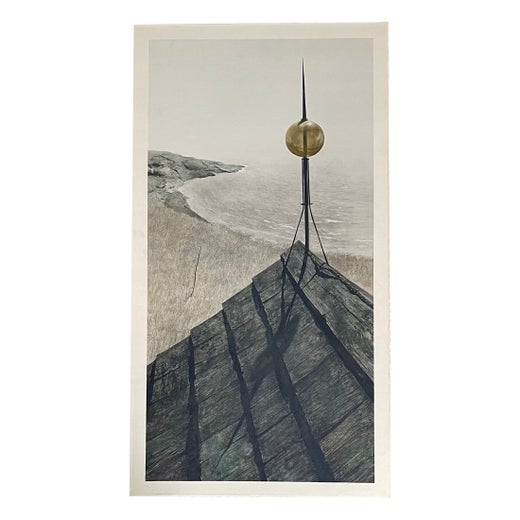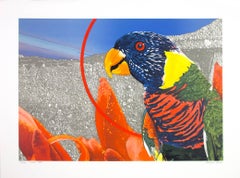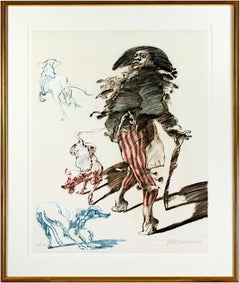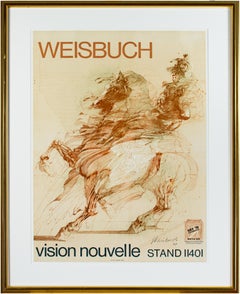Want more images or videos?
Request additional images or videos from the seller
1 of 8
Andrew Wyeth"Dog on Bed, " Giclee Print by Andrew Wyeth2019
2019
Price:$448
$560List Price
About the Item
- Creator:Andrew Wyeth (1917-2009, American)
- Creation Year:2019
- Dimensions:Height: 22.25 in (56.52 cm)Width: 27.25 in (69.22 cm)
- Medium:
- Movement & Style:
- Period:
- Condition:
- Gallery Location:Milwaukee, WI
- Reference Number:Seller: 14014g1stDibs: LU60535176952
Andrew Wyeth
An artist who pursued his own course when the rest of the art world was consumed with modernism and abstraction, Wyeth is considered among the preeminent representational painters of the 20th century. Born in Chadds Ford, Pennsylvania, Wyeth drew his subject matter from the world around him: the interiors and exteriors of the stone buildings, mills, and farms of the Brandywine River countryside, and in the summers, the clapboard houses and stark landscape of the Maine coast. After his father died in a 1945 automobile accident, Wyeth began to incorporate people into his pictures, most notably Christina Olson, and later Siri Erickson, of Cushing, Maine, and his Chadds Ford neighbors Karl and Anna Kuerner and Helga Testorf. The first visual artist to appear on the cover of Time magazine, Wyeth was also the first living American-born artist to be given an exhibition at The Metropolitan Museum of Art in New York. Wyeth’s naturalistic style is marked by strong editing combined with remarkable execution of details. While relying on keen visual observation, he pared down the elements of a composition to their most essential, giving his works an abstracted quality and imbuing them with a sense of quietude and stillness. The egg tempera medium (which he came to prefer to oil after first experimenting with it in the early 1940s) lent itself to the precise detailing required to create his subtle textural effects, since it dries quickly and translucent layers can be built up over one another. Wyeth also painted extensively in watercolor in works of more spontaneous execution, as well as in the drybrush technique (where most water is removed from the watercolor medium), sometimes combining the two.
About the Seller
4.9
Gold Seller
Premium sellers maintaining a 4.3+ rating and 24-hour response times
Established in 1966
1stDibs seller since 2017
451 sales on 1stDibs
Typical response time: 2 hours
Authenticity Guarantee
In the unlikely event there’s an issue with an item’s authenticity, contact us within 1 year for a full refund. DetailsMoney-Back Guarantee
If your item is not as described, is damaged in transit, or does not arrive, contact us within 7 days for a full refund. Details24-Hour Cancellation
You have a 24-hour grace period in which to reconsider your purchase, with no questions asked.Vetted Professional Sellers
Our world-class sellers must adhere to strict standards for service and quality, maintaining the integrity of our listings.Price-Match Guarantee
If you find that a seller listed the same item for a lower price elsewhere, we’ll match it.Trusted Global Delivery
Our best-in-class carrier network provides specialized shipping options worldwide, including custom delivery.You May Also Like
Tiger 1, David Hunt, Limited Edition Print, Animal Artwork, Black And White Art
By David Hunt
Located in Deddington, GB
David Hunt
Tiger 1
Limited Edition Giclee Print
Edition of 10
Framed Size: H 84cm x W 84cm x D 3.5cm
Sold Framed
Please note that in situ images are purely an indication of how a piece may look.
Tiger 1 is an original work on paper by artist, David Hunt.
David Hunt comments "after a career that has ranged from working on oil rigs in Africa and Central Asia to running my own business building shepherd's huts for private clients I have now returned to my first loves of drawing and draftsmanship. I am mostly self taught and have studied intaglio etching techniques with john Howard R.E. and Melvyn...
Category
21st Century and Contemporary Realist Animal Prints
Materials
Giclée
$1,407
Free Shipping
H 33.08 in W 33.08 in D 1.38 in
Golden Retrievers Framed in Triptych Bottoms Up, BYOB and Shaken Not Stirred
Located in Charleston, US
Three charming giclees of Golden Retriever dog paintings by Karen Killian are attractively framed in a gray wood floater. How clever that the dog paintings have titles of Bottom's U...
Category
2010s Realist Animal Prints
Materials
Giclée
Blu on Red, limited edition print by world renowned female portrait artist
By Brenda Zlamany
Located in New York, NY
Brenda Zlamany
Blu on Red, 2013
Limited Edition special giclee print.
Hand signed and numbered. Edition of 100
19 1/2 × 19 1/2 inches
Unframed
Gorgeous giclee print based upon an o...
Category
2010s Realist Animal Prints
Materials
Pencil, Giclée
"Course Dog" Limited Edition Giclee Print, 30" x 30"
Located in Westport, CT
This abstracted print of a dog by artist Russell Miyaki features a light neutral palette with colorful accents and expressive, playful elements to create an energetic composition of ...
Category
2010s Abstract Animal Prints
Materials
Digital, Giclée
$1,125
H 32 in W 32 in D 2.5 in
"Colorful Basenji" Limited Edition Giclee Print, 36" x 36"
Located in Westport, CT
This abstracted print of a dog by artist Russell Miyaki features an earthy neutral palette and captures a brown dog in profile in front of a white background. It pairs larger abstrac...
Category
2010s Abstract Animal Prints
Materials
Digital, Giclée
$1,225
H 38 in W 38 in D 2.5 in
"A Good Day" Limited Edition Giclee Print, 40" x 40"
Located in Westport, CT
This abstracted print of a dog by artist Russell Miyaki features a light, colorful palette and loose, expressive, and playful elements to create an energetic composition of a dog wit...
Category
2010s Abstract Animal Prints
Materials
Digital, Giclée
$1,375
H 42 in W 42 in D 2.5 in
"Soulful Gaze" Limited Edition Giclee Print, 40" x 40"
Located in Westport, CT
This abstracted print of a dog by artist Russell Miyaki features a vibrant palette, with a brown dog from the shoulders up, wearing a bright orange collar in front of a bright, half ...
Category
2010s Abstract Animal Prints
Materials
Digital, Giclée
$1,375
H 42 in W 42 in D 2.5 in
"A Good Day" Limited Edition Giclee Print, 53" x 53"
Located in Westport, CT
This abstracted print of a dog by artist Russell Miyaki features a light, colorful palette and loose, expressive, and playful elements to create an energetic composition of a dog wit...
Category
2010s Abstract Animal Prints
Materials
Digital, Giclée
$1,700
H 55 in W 55 in D 2.5 in
"Dandy Dal" Limited Edition Giclee Print, 24" x 24"
Located in Westport, CT
This abstracted print of a dog by artist Russell Miyaki features a light neutral palette with expressive, playful elements to create an energetic composition of a Dalmatian with his ...
Category
2010s Abstract Animal Prints
Materials
Digital, Giclée
"Soulful Gaze" Limited Edition Giclee Print, 36" x 36"
Located in Westport, CT
This abstracted print of a dog by artist Russell Miyaki features a vibrant palette, with a brown dog from the shoulders up, wearing a bright orange collar in front of a bright, half ...
Category
2010s Abstract Animal Prints
Materials
Digital, Giclée
$1,225
H 38 in W 38 in D 2.5 in
More From This Seller
View All"Finest Hope" original lithograph signed pop art abstract hyperrealism collage
By Michael Knigin
Located in Milwaukee, WI
"Finest Hope" is an original color lithograph by Michael Knigin. The artist signed the piece in the lower right and wrote the edition number, 182/300, in the lower left with graphite...
Category
1980s Realist Animal Prints
Materials
Lithograph, Ink
19th century black and white etching aquatint outdoors figurative animal print
By Camille Pissarro
Located in Milwaukee, WI
"Vachere au Bord de L'Eau" is an original etching and aquatint by Camille Pissarro, the 8th state. It can be found in the catalogue raisonne Delteil #93. It features a woman sitting ...
Category
1890s Realist Figurative Prints
Materials
Etching, Aquatint
'Polichinelle Et Ses Trois Chiens' original signed lithograph, Pulcinella & dogs
By Claude Weisbuch
Located in Milwaukee, WI
'Polichinelle Et Ses Trois Chiens,' or in English 'Pulcinella and His Three Dogs,' is an original signed lithograph by the contemporary artist Claude Weisbuch – and it is an excellen...
Category
1980s Contemporary Figurative Prints
Materials
Lithograph
'Le Condottiere' original signed lithograph poster, knight on horseback 1970s
By Claude Weisbuch
Located in Milwaukee, WI
This poster, produced for the 1978 International Meeting of Fine Art Dealers in Washington, features prominently one of Claude Weisbuch's dynamic images: Le Condottiere. It is an original color lithograph advertising his new works, and is one of only twenty-five that bears the artist's signature in the lower right. In line with Weisbuch's interest in the Renaissance and Baroque in Europe, this image looks back to the early modern period. Condottieri were Italian captains...
Category
1970s Contemporary Figurative Prints
Materials
Lithograph
'Boeuf Ecorche' original signed lithograph, Rembrandt with slaughtered ox 1970s
By Claude Weisbuch
Located in Milwaukee, WI
'Boeuf Ecorche' is an original color lithograph, signed by Claude Weisbuch – and it is a quintessential example of the contemporary artist's interest in the old masters. In the image...
Category
1970s Contemporary Figurative Prints
Materials
Lithograph
19th century color lithograph birds landscape nature grass sky water figure
By Currier & Ives
Located in Milwaukee, WI
"Shooting on the Prairie" is an original hand-colored lithograph by Currier & Ives. It depicts a hunter shooting at fowl in an open field.
8 1/2" x 12 1/2" art
20 1/4" x 23 3/4" frame
Nathaniel Currier was a tall introspective man with a melancholy nature. He could captivate people with his piercing stare or charm them with his sparkling blue eyes. Nathaniel was born in Roxbury, Massachusetts on March 27th, 1813, the second of four children. His parents, Nathaniel and Hannah Currier, were distant cousins who lived a humble yet spartan life. When Nathaniel was eight years old, tragedy struck. Nathaniel’s father unexpectedly passed away leaving Nathaniel and his eleven-year-old brother Lorenzo to provide for the family. In addition to their mother, Nathaniel and Lorenzo had to care for six-year-old sister Elizabeth and two-year-old brother Charles. Nathaniel worked a series of odd jobs to support the family, and at fifteen, he started what would become a life-long career when he apprenticed in the Boston lithography shop of William and John Pendleton.
A Bavarian gentleman named Alois Senefelder invented lithography just 30 years prior to young Nat Currier’s apprenticeship. While under the employ of the brothers Pendleton, Nat was taught the art of lithography by the firm’s chief printer, a French national named Dubois, who brought the lithography trade to America.
Lithography involves grinding a piece of limestone flat and smooth then drawing in mirror image on the stone with a special grease pencil. After the image is completed, the stone is etched with a solution of aqua fortis leaving the greased areas in slight relief. Water is then used to wet the stone and greased-ink is rolled onto the raised areas. Since grease and water do not mix, the greased-ink is repelled by the moisture on the stone and clings to the original grease pencil lines. The stone is then placed in a press and used as a printing block to impart black on white images to paper.
In 1833, now twenty-years old and an accomplished lithographer, Nat Currier left Boston and moved to Philadelphia to do contract work for M.E.D. Brown, a noted engraver and printer. With the promise of good money, Currier hired on to help Brown prepare lithographic stones of scientific images for the American Journal of Sciences and Arts. When Nat completed the contract work in 1834, he traveled to New York City to work once again for his mentor John Pendleton, who was now operating his own shop located at 137 Broadway. Soon after the reunion, Pendleton expressed an interest in returning to Boston and offered to sell his print shop to Currier. Young Nat did not have the financial resources to buy the shop, but being the resourceful type he found another local printer by the name of Stodart. Together they bought Pendleton’s business.
The firm ‘Currier & Stodart’ specialized in "job" printing. They produced many different types of printed items, most notably music manuscripts for local publishers. By 1835, Stodart was frustrated that the business was not making enough money and he ended the partnership, taking his investment with him. With little more than some lithographic stones, and a talent for his trade, twenty-two year old Nat Currier set up shop in a temporary office at 1 Wall Street in New York City. He named his new enterprise ‘N. Currier, Lithographer’
Nathaniel continued as a job printer and duplicated everything from music sheets to architectural plans. He experimented with portraits, disaster scenes and memorial prints, and any thing that he could sell to the public from tables in front of his shop. During 1835 he produced a disaster print Ruins of the Planter's Hotel, New Orleans, which fell at two O’clock on the Morning of the 15th of May 1835, burying 50 persons, 40 of whom Escaped with their Lives. The public had a thirst for newsworthy events, and newspapers of the day did not include pictures. By producing this print, Nat gave the public a new way to “see” the news. The print sold reasonably well, an important fact that was not lost on Currier.
Nat met and married Eliza Farnsworth in 1840. He also produced a print that same year titled Awful Conflagration of the Steamboat Lexington in Long Island Sound on Monday Evening, January 18, 1840, by which melancholy occurrence over One Hundred Persons Perished. This print sold out very quickly, and Currier was approached by an enterprising publication who contracted him to print a single sheet addition of their paper, the New York Sun. This single page paper is presumed to be the first illustrated newspaper ever published.
The success of the Lexington print launched his career nationally and put him in a position to finally lift his family up. In 1841, Nat and Eliza had their first child, a son they named Edward West Currier. That same year Nat hired his twenty-one year old brother Charles and taught him the lithography trade, he also hired his artistically inclined brother Lorenzo to travel out west and make sketches of the new frontier as material for future prints. Charles worked for the firm on and off over the years, and invented a new type of lithographic crayon which he patented and named the Crayola. Lorenzo continued selling sketches to Nat for the next few years.
In 1843, Nat and Eliza had a daughter, Eliza West Currier, but tragedy struck in early 1847 when their young daughter died from a prolonged illness. Nat and Eliza were grief stricken, and Eliza, driven by despair, gave up on life and passed away just four months after her daughter’s death.
The subject of Nat Currier’s artwork changed following the death of his wife and daughter, and he produced many memorial prints and sentimental prints during the late 1840s. The memorial prints generally depicted grief stricken families posed by gravestones (the stones were left blank so the purchasers could fill in the names of the dearly departed). The sentimental prints usually depicted idealized portraits of women and children, titled with popular Christian names of the day.
Late in 1847, Nat Currier married Lura Ormsbee, a friend of the family. Lura was a self-sufficient woman, and she immediately set out to help Nat raise six-year-old Edward and get their house in order. In 1849, Lura delivered a son, Walter Black Currier, but fate dealt them a blow when young Walter died one year later. While Nat and Lura were grieving the loss of their new son, word came from San Francisco that Nat’s brother Lorenzo had also passed away from a brief illness. Nat sank deeper into his natural quiet melancholy. Friends stopped by to console the couple, and Lura began to set an extra place at their table for these unexpected guests. She continued this tradition throughout their lives.
In 1852, Charles introduced a friend, James Merritt Ives, to Nat and suggested he hire him as a bookkeeper. Jim Ives was a native New Yorker born in 1824 and raised on the grounds of Bellevue Hospital where his father was employed as superintendent. Jim was a self-trained artist and professional bookkeeper. He was also a plump and jovial man, presenting the exact opposite image of his new boss.
Jim Ives met Charles Currier through Caroline Clark, the object of Jim’s affection. Caroline’s sister Elizabeth was married to Charles, and Caroline was a close friend of the Currier family. Jim eventually proposed marriage to Caroline and solicited an introduction to Nat Currier, through Charles, in hopes of securing a more stable income to support his future wife.
Ives quickly set out to improve and modernize his new employer’s bookkeeping methods. He reorganized the firm’s sizable inventory, and used his artistic skills to streamline the firm’s production methods. By 1857, Nathaniel had become so dependent on Jims’ skills and initiative that he offered him a full partnership in the firm and appointed him general manager. The two men chose the name ‘Currier & Ives’ for the new partnership, and became close friends.
Currier & Ives produced their prints in a building at 33 Spruce Street where they occupied the third, fourth and fifth floors. The third floor was devoted to the hand operated printing presses that were built by Nat's cousin, Cyrus Currier, at his shop Cyrus Currier & Sons in Newark, NJ. The fourth floor found the artists, lithographers and the stone grinders at work. The fifth floor housed the coloring department, and was one of the earliest production lines in the country. The colorists were generally immigrant girls, mostly German, who came to America with some formal artistic training. Each colorist was responsible for adding a single color to a print. As a colorist finished applying their color, the print was passed down the line to the next colorist to add their color. The colorists worked from a master print displayed above their table, which showed where the proper colors were to be placed. At the end of the table was a touch up artist who checked the prints for quality, touching-in areas that may have been missed as it passed down the line. During the Civil War, demand for prints became so great that coloring stencils were developed to speed up production.
Although most Currier & Ives prints were colored in house, some were sent out to contract artists. The rate Currier & Ives paid these artists for coloring work was one dollar per one hundred small folios (a penny a print) and one dollar per one dozen large folios. Currier & Ives also offered uncolored prints to dealers, with instructions (included on the price list) on how to 'prepare the prints for coloring.' In addition, schools could order uncolored prints from the firm’s catalogue to use in their painting classes.
Nathaniel Currier and James Merritt Ives attracted a wide circle of friends during their years in business. Some of their more famous acquaintances included Horace Greeley, Phineas T. Barnum, and the outspoken abolitionists Rev. Henry Ward, and John Greenleaf Whittier (the latter being a cousin of Mr. Currier).
Nat Currier and Jim Ives described their business as "Publishers of Cheap and Popular Pictures" and produced many categories of prints. These included Disaster Scenes, Sentimental Images, Sports, Humor, Hunting Scenes, Politics, Religion, City and Rural Scenes, Trains, Ships, Fire Fighters, Famous Race Horses, Historical Portraits, and just about any other topic that satisfied the general public's taste. In all, the firm produced in excess of 7500 different titles, totaling over one million prints produced from 1835 to 1907.
Nat Currier retired in 1880, and signed over his share of the firm to his son Edward. Nat died eight years later at his summer home 'Lion’s Gate' in Amesbury, Massachusetts. Jim Ives remained active in the firm until his death in 1895, when his share of the firm passed to his eldest son, Chauncey.
In 1902, faced will failing health from the ravages of Tuberculosis, Edward Currier sold his share of the firm to Chauncey Ives...
Category
1870s Other Art Style Animal Prints
Materials
Lithograph




